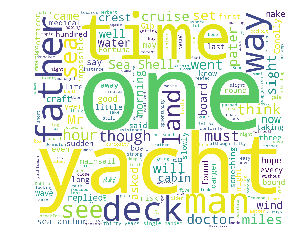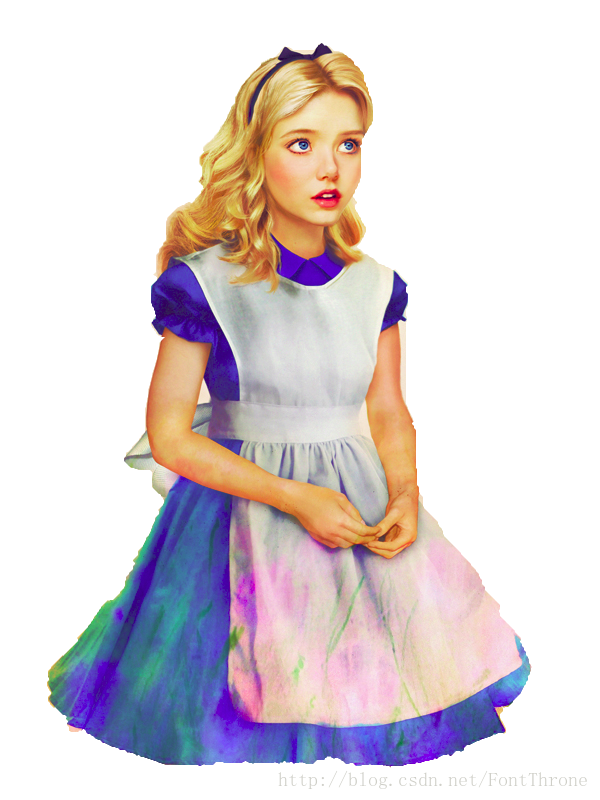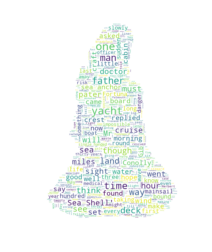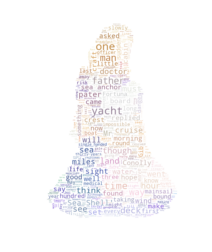词云wordcloud入门示例
整体简介:
词云图,也叫文字云,是对文本中出现频率较高的“关键词”予以视觉化的展现,词云图过滤掉大量的低频低质的文本信息,使得浏览者只要一眼扫过文本就可领略文本的主旨。
基于Python的词云生成类库,很好用,而且功能强大。在做统计分析的时候有着很好的应用,比较推荐。
github:https://github.com/amueller/word_cloud
官方地址:https://amueller.github.io/word_cloud/
快速生成词云:
#导入所需库
from wordcloud import WordCloud
f = open(r'C:\Users\JluTIger\Desktop\texten.txt','r').read()
wordcloud = WordCloud(background_color="white",width=1000, height=860, margin=2).generate(f) # width,height,margin可以设置图片属性
# generate 可以对全部文本进行自动分词,但是对中文支持不好
# 可以设置font_path参数来设置字体集
#background_color参数为设置背景颜色,默认颜色为黑色 import matplotlib.pyplot as plt
plt.imshow(wordcloud)
plt.axis("off")
plt.show()
wordcloud.to_file('test.png')
# 保存图片,但是在第三模块的例子中 图片大小将会按照 mask 保存
- 运行时遇到的问题:
报错:(unicode error) 'unicodeescape' codec can't decode bytes in position 2-3: truncated \UXXXXXXXX escap
- 原因及解决办法:
文档我是放在桌面里的,起初读取文档的命令是:f = open('C:\Users\JluTIger\Desktop\texten.txt','r').read()
一直报错:(unicode error) 'unicodeescape' codec can't decode bytes in position 2-3: truncated \UXXXXXXXX escape
后来发现,在Python中\是转义符,\u表示其后是UNICODE编码,因此\User在这里会报错,在字符串前面加个r表示就可以了
- 效果:

自定义字体颜色:
下段代码来自wordcloud官方的github。
#!/usr/bin/env python
"""
Colored by Group Example
======================== Generating a word cloud that assigns colors to words based on
a predefined mapping from colors to words
基于颜色到单次的映射,将颜色分配给单次,生成词云。
""" from wordcloud import (WordCloud, get_single_color_func)
import matplotlib.pyplot as plt class SimpleGroupedColorFunc(object):
"""Create a color function object which assigns EXACT colors
to certain words based on the color to words mapping
创建一个颜色函数对象,它根据颜色到单词的映射关系,为单词分配精准的颜色。 Parameters
参数
----------
color_to_words : dict(str -> list(str))
A dictionary that maps a color to the list of words. default_color : str
Color that will be assigned to a word that's not a member
of any value from color_to_words.
""" def __init__(self, color_to_words, default_color):
self.word_to_color = {word: color
for (color, words) in color_to_words.items()
for word in words} self.default_color = default_color def __call__(self, word, **kwargs):
return self.word_to_color.get(word, self.default_color) class GroupedColorFunc(object):
"""Create a color function object which assigns DIFFERENT SHADES of
specified colors to certain words based on the color to words mapping. Uses wordcloud.get_single_color_func Parameters
----------
color_to_words : dict(str -> list(str))
A dictionary that maps a color to the list of words. default_color : str
Color that will be assigned to a word that's not a member
of any value from color_to_words.
""" def __init__(self, color_to_words, default_color):
self.color_func_to_words = [
(get_single_color_func(color), set(words))
for (color, words) in color_to_words.items()] self.default_color_func = get_single_color_func(default_color) def get_color_func(self, word):
"""Returns a single_color_func associated with the word"""
try:
color_func = next(
color_func for (color_func, words) in self.color_func_to_words
if word in words)
except StopIteration:
color_func = self.default_color_func return color_func def __call__(self, word, **kwargs):
return self.get_color_func(word)(word, **kwargs) #text是要分析的文本内容
text = """The Zen of Python, by Tim Peters
Beautiful is better than ugly.
Explicit is better than implicit.
Simple is better than complex.
Complex is better than complicated.
Flat is better than nested.
Sparse is better than dense.
Readability counts.
Special cases aren't special enough to break the rules.
Although practicality beats purity.
Errors should never pass silently.
Unless explicitly silenced.
In the face of ambiguity, refuse the temptation to guess.
There should be one-- and preferably only one --obvious way to do it.
Although that way may not be obvious at first unless you're Dutch.
Now is better than never.
Although never is often better than *right* now.
If the implementation is hard to explain, it's a bad idea.
If the implementation is easy to explain, it may be a good idea.
Namespaces are one honking great idea -- let's do more of those!""" # Since the text is small collocations are turned off and text is lower-cased
wc = WordCloud(collocations=False).generate(text.lower()) # 自定义所有单词的颜色
color_to_words = {
# words below will be colored with a green single color function
'#00ff00': ['beautiful', 'explicit', 'simple', 'sparse',
'readability', 'rules', 'practicality',
'explicitly', 'one', 'now', 'easy', 'obvious', 'better'],
# will be colored with a red single color function
'red': ['ugly', 'implicit', 'complex', 'complicated', 'nested',
'dense', 'special', 'errors', 'silently', 'ambiguity',
'guess', 'hard']
} # Words that are not in any of the color_to_words values
# will be colored with a grey single color function
#不属于上述设定的颜色词的词语会用灰色来着色
default_color = 'grey' # Create a color function with single tone
# grouped_color_func = SimpleGroupedColorFunc(color_to_words, default_color) # Create a color function with multiple tones
grouped_color_func = GroupedColorFunc(color_to_words, default_color) # Apply our color function
# 如果你也可以将color_func的参数设置为图片,详细的说明请看 下一部分
wc.recolor(color_func=grouped_color_func) # 画图
plt.figure()
plt.imshow(wc, interpolation="bilinear")
plt.axis("off")
plt.show()
- 效果:

利用背景图片生成词云,设置停用词词集:
该段代码主要来自于wordcloud的github,你同样可以在github下载该例子以及原图片与效果图。wordcloud会把背景图中白色区域去除,只在有色区域进行绘制。
#!/usr/bin/env python
"""
Image-colored wordcloud
======================= You can color a word-cloud by using an image-based coloring strategy
implemented in ImageColorGenerator. It uses the average color of the region
occupied by the word in a source image. You can combine this with masking -
pure-white will be interpreted as 'don't occupy' by the WordCloud object when
passed as mask.
If you want white as a legal color, you can just pass a different image to
"mask", but make sure the image shapes line up.
"""
#导入必要的库
from os import path
from PIL import Image
import numpy as np
import matplotlib.pyplot as plt from wordcloud import WordCloud, STOPWORDS, ImageColorGenerator # Read the whole text.
text = open(r'C:\Users\JluTIger\Desktop\texten.txt').read() # read the mask / color image taken from
# http://jirkavinse.deviantart.com/art/quot-Real-Life-quot-Alice-282261010
alice_coloring = np.array(Image.open(r"C:\Users\JluTIger\Desktop\alice.png")) # 设置停用词
stopwords = set(STOPWORDS)
stopwords.add("said") # 你可以通过 mask 参数 来设置词云形状
wc = WordCloud(background_color="white", max_words=2000, mask=alice_coloring,
stopwords=stopwords, max_font_size=40, random_state=42)
# generate word cloud
wc.generate(text) # create coloring from image
image_colors = ImageColorGenerator(alice_coloring) # show
# 在只设置mask的情况下,你将会得到一个拥有图片形状的词云
plt.imshow(wc, interpolation="bilinear")
plt.axis("off")
plt.figure()
# recolor wordcloud and show
# we could also give color_func=image_colors directly in the constructor
# 我们还可以直接在构造函数中直接给颜色
# 通过这种方式词云将会按照给定的图片颜色布局生成字体颜色策略
plt.imshow(wc.recolor(color_func=image_colors), interpolation="bilinear")
plt.axis("off")
plt.figure()
plt.imshow(alice_coloring, cmap=plt.cm.gray, interpolation="bilinear")
plt.axis("off")
plt.show()
- 请注意自己的路径设置
- 原图

- 效果:


词云wordcloud入门示例的更多相关文章
- scrapy-redis爬取豆瓣电影短评,使用词云wordcloud展示
1.数据是使用scrapy-redis爬取的,存放在redis里面,爬取的是最近大热电影<海王> 2.使用了jieba中文分词解析库 3.使用了停用词stopwords,过滤掉一些无意义的 ...
- 词云wordcloud类介绍&python制作词云图&词云图乱码问题等小坑
词云图,大家一定见过,大数据时代大家经常见,我们今天就来用python的第三方库wordcloud,来制作一个大数据词云图,同时会降到这个过程中遇到的各种坑, 举个例子,下面是我从自己的微信上抓的微信 ...
- Python - 利用词云wordcloud,jieba和中国地图制作四大名著的热词图
热词图很酷炫,也非常适合热点事件,抓住重点,以图文结合的方式表现出来,很有冲击力.下面这段代码是制作热词图的,用到了以下技术: jieba,把文本分词 wordcloud,制作热图 chardet,辨 ...
- 词云-wordcloud
import jiebabook = "2015.txt"txt = open(book).read()ex = {'不是','就是','的话','1.1','docin','ww ...
- python抓取数据构建词云
1.词云图 词云图,也叫文字云,是对文本中出现频率较高的"关键词"予以视觉化的展现,词云图过滤掉大量的低频低质的文本信息,使得浏览者只要一眼扫过文本就可领略文本的主旨. 先看几个词 ...
- 已知词频生成词云图(数据库到生成词云)--generate_from_frequencies(WordCloud)
词云图是根据词出现的频率生成词云,词的字体大小表现了其频率大小. 写在前面: 用wc.generate(text)直接生成词频的方法使用很多,所以不再赘述. 但是对于根据generate_from_f ...
- 用Python生成词云
词云以词语为基本单元,根据词语在文本中出现的频率设计不同大小的形状以形成视觉上的不同效果,从而使读者只要“一瞥“即可领略文本的主旨.以下是一个词云的简单示例: import jieba from wo ...
- 如何用Python 制作词云-对1000首古诗做词云分析
公号:码农充电站pro 主页:https://codeshellme.github.io 今天来介绍一下如何使用 Python 制作词云. 词云又叫文字云,它可以统计文本中频率较高的词,并将这些词可视 ...
- 用Python玩转词云
第一步:引入相关的库包: #coding:utf-8 __author__ = 'Administrator' import jieba #分词包 import numpy #numpy计算包 imp ...
随机推荐
- 升级mac自带的python
系统自带的Python $ which python 终端输出 /usr/bin/python 使用Homebrew安装最新的Python2 为什么要使用Homebrew安装Python? 总能下载到 ...
- 洛谷P4578 [FJOI2018]所罗门王的宝藏(dfs)
题意 题目链接 Sol 对于每个询问\(x, y, c\) 从在\((x, y)\)之间连一条边权为\(c\)的双向边,然后就是解\(K\)个二元方程. 随便带个数进去找找环就行了 #include& ...
- HTML之元素分类(HTML基础知识)
HTML之元素分类 一.按照块级元素还是行内元素分类 块级元素(block-level)和行内元素(inline-level,也叫作“内联”元素). a.块级元素(独占一行) 块级元素:其最明显的特征 ...
- Windows 批处理获取某路径下最新创建的文件的名称
批处理获取某路径下最新创建的文件的名称 by:授客 QQ:1033553122 echo off setlocal enabledelayedexpansion rem 设置文件所在目录 set sr ...
- C# 实现中国象棋【棋盘,棋子】
本文是利用C# 实现中国象棋的棋盘绘制,以及初始化布局,并不实现中国象棋的对弈逻辑.仅供学习参考使用. 思路: 绘制中国象棋棋盘,竖线九条,横线十条.再中间绘制‘楚河’,‘汉界’ . 绘制棋子,然后将 ...
- ajax post 提交数据和文件
方式一:常用的方式是通过form.serialize()获取表单数据,但是,这样有个弊端,文件不能上传 $.ajax({ url:'/communication/u/', type:'POST', d ...
- [Python] wxPython 基本控件 (转)
转自:http://www.cnblogs.com/wangjian8888/p/6028777.html 一.静态文本控件 wx.StaticText(parent, id, label, pos= ...
- BitnamiRedmine配置邮件系统备忘
前几天安装的Redmine邮件系统存在问题,需要换一个,方法记录如下: 修改配置文件: cd ~/redmine/apps/redmine/htdocs/config vi configuration ...
- GPA简介
GPA(Graphics Performance Analyzers)是Intel公司提供的一款免费的跨平台性能分析工具. 填写e-mail.name和country并提交后,就会收到一封有专属下载链 ...
- element-ui的table动态生成表头和数据,且表中数据可编辑
1.实现表头的动态渲染 2.表头label和prop字段都要定义 3.去判断显示那个数据表 4.实现双击的时候在可编辑 // 双击修改 弹出input tableDbEdit(row, column, ...
